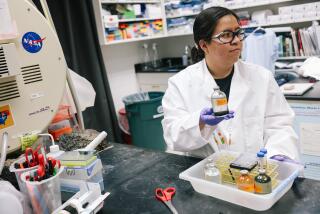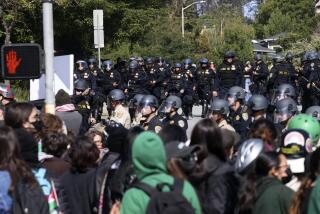Researchers Comb Charred Labs for Data
Biology professors at UC Santa Cruz spent the weekend sifting through the charred, waterlogged remains of their laboratories, hoping to salvage data and notes after a fire ripped through their building Friday morning.
The Sinsheimer Laboratories building houses researchers who study topics ranging from the cell cycle of fruit flies to genetic functioning within cells. Some of the destroyed work was related to the Human Genome Project, a national effort to identify the chemical composition of human DNA.
As investigators work to determine the fire’s cause, researchers said they intend to carry on their work, although it could take a while to get back on track.
“Money is the biggest problem right now,” said Valerie Welch, a third-year graduate student in the worst-damaged lab. “That’s just to get us started. It doesn’t do anything to replace the history of what people in the lab have lost.”
Welch and her advisor, biology professor Manuel Ares, are examining how cells decide which genetic information is needed to create proteins. Those proteins then drive the chemical reactions that are necessary to sustain life.
The research team examines how genes act differently in healthy and diseased cells.
Ares said he had been accumulating genetic strains in his lab during his 14 years at the university. Those strains must now be re-created, which will cost tens of thousands of dollars, he said.
“Right now, we’re still struggling with some of the immediate concerns of getting things together,” said Ares, chairman of the molecular, cell and developmental biology department.
“It’s kind of a devastating thing scientifically, but it’s also very devastating for the people working in the lab. They’re dedicated to what some people might consider minutiae, yet it’s a major part of their life and their identity.”
Welch said she has backed up most of her research on other UC Santa Cruz computers, but the fire probably will set her project’s completion back six months to a year.
Researchers will not be allowed to reoccupy the offices for two to four weeks, university spokesman Jim Burns said, because workers are cleaning up the building, pumping out water, and drying walls and ceilings. Colleagues in other buildings have offered to share research space in the meantime, Ares said.
The three-alarm fire broke out about 5:30 a.m. Friday on the fourth floor of Sinsheimer, the primary biology building. No one was injured.
University officials said the fire is being investigated by the state fire marshal’s office and the California Department of Forestry, and it could be several days before a cause is determined.
Burns said he does not have a dollar estimate for the damage.
The fire gutted the labs of Ares and Jane Silverthorne, an associate biology professor on a leave of absence to work at the National Science Foundation. Her work focuses primarily on the molecular biology of plant development.
Silverthorne said she has not seen her lab. Because the lab did not house ongoing research, she is reasonably confident that she can reconstruct it.
“The good thing is that scientists often share materials with each other and also deposit them” in storage centers, she said. “When something like this happens, you can get them back.”
The 28 other labs in the building suffered some damage, Ares said. Among them are the labs of associate biology professor John Tamkun, who is studying the gene expression of fruit flies, and Harry Noller, a molecular biology professor who is examining ribosomes, the protein factories of all living cells. Ribosomes hold the mechanisms needed to read the genetic code and translate it into specific protein structures.
Tamkun said his office looks like “someone took a hose to it.” But remarkably, university personnel were able to recover vials containing 1,000 strains of live fruit flies. Only five strains were lost, and they were not too important, he said.
“I almost feel guilty at how little we lost,” he said. “It could have been much, much, much, much worse.”
Welch said researchers in her lab are committed to overcoming the setback and moving forward.
“We’re going to rebuild,” she said. “Everyone in the lab feels really strongly about their research. It’s just a matter of time and money. It may be a slow process, but we want to do it.”






